 |
 |
 |
| |
Subgroup Analyses from STARTMRK, a Phase III Study of Raltegravir (RAL)-Based vs Efavirenz (EFV)-Based Combination Therapy in Treatment-Naïve HIV-Infected Patients
|
| |
| |
Reported by Jules Levin
CROI 2009 Feb 8-12 Montreal
Jeffrey Lennox1, Edwin DeJesus2, Adriano Lazzarin3, Richard Pollard 4, Jose Valdez Ramalho Madruga 5, Jing Zhao 6, Anthony Rodgers , Bach-Yen Nguyen6 , Randi Leavitt 6, and Peter Sklar6
1Emory University Center for AIDS Research, Atlanta, GA; 2Orlando Immunology Center, Orlando, FL; 3Univ Vita-Salute San Raffaele, Milan, Italy;
4University of California at Davis, Sacramento, CA; 5 Centro de Referencia Treinamento DST/AIDS, Sao Paulo, Brazil; 6Merck & Co., Inc., West Point, PA
AUTHOR CONCLUSIONS
In the STARTMRK trial of combination antiretroviral therapy in previously untreated patients, RAL with TDF/FTC demonstrated consistent virologic and immunologic efficacy relative to EFV with TDF/FTC across demographic and baseline prognostic factors, including:
Baseline plasma vRNA level >100,000 copies/mL: Both RAL and EFV demonstrated comparable efficacy in patients with high baseline viral loads (>100,000 copies/mL) compared to patients with lower viral loads
Baseline CD4 count ≦50 cells/mm3
--Response rates for both RAL and EFV recipients were numerically slightly lower in patients with low baseline CD4 cells (≦200 cells/mm3) compared to patients with higher CD4 cells
Demographic groups (including age, gender, region, and race)
Viral subtypes (comparing non-clade B as a group to clade B)
ABSTRACT
Background: In treatment-naive patients given 48 weeks (wk) of therapy, RAL+tenofovir (TDF)/ emtricitabine (FTC) had non-inferior antiretroviral activity compared to EFV+TDF/FTC and was associated with greater increases in CD4 cell counts.
Methods: Patients with HIV RNA levels >5000 c/mL and no resistance to EFV, TDF or FTC were eligible for a blinded randomized study of RAL (400 mg bid) vs EFV (600 mg qhs), each with TDF/FTC. Stratification was by screening RNA (≦/> 50,000 c/mL) and hepatitis status. Results for the primary and secondary endpoints (% of patients achieving RNA <50 c/mL and <400 c/mL at Wk 48, and change from baseline in CD4 cell count at Wk 48) were summarized within several prespecified subgroups in order to further characterize the effect of RAL. Summary statistics [along with 95% confidence intervals (CI)] were provided by treatment group within each subgroup using the observed failure (OF) approach.
Results: Of 563 treated patients, 19% were female, 58% were non-white, and region of residence was Latin America (35%), North America (31%), EU/Australia (23%) and Asia (11%). Median age was 37 years. 53% had vRNA >100,000 c/mL, 48% had CD4 counts <200 cells/mm3 at entry, and 19% were infected with nonsubtype B HIV. RAL and EFV had virologic efficacy that was generally consistent across baseline demographic factors. Table summarizes the proportion of patients with vRNA <50 c/mL at Wk 48 by selected baseline factors. RAL demonstrated greater CD4 cell increases than EFV at Wk 48 that was consistent across baseline demographic factors. RAL was in general well tolerated.
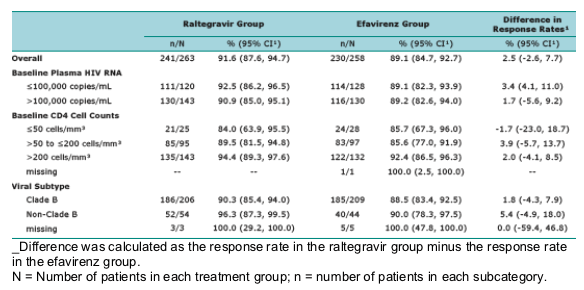
Conclusion: RAL demonstrated consistent virologic and immunologic efficacy across demographic and all baseline prognostic factors, including baseline plasma vRNA level >100,000 c/mL, baseline CD4 count ≦50 cells/mm3, gender/racial groups, and viral subtypes.
STUDY DESIGN
- Double-blind, randomized (1:1), non-inferiority study
- RAL 400 mg b.i.d. vs EFV 600 mg q.h.s. both in combination with tenofovir/emtricitabine (TDF/FTC as TRUVADA)
- Key inclusion criteria
- no prior ART
- HIV RNA level >5000 copies/mL
- viral susceptibility to EFV, TDF, and FTC
- Endpoints
- Efficacy: Proportion with HIV RNA levels < 50 copies/mL, change in CD4 cell counts
- Safety/tolerability: adverse experiences; central nervous system (CNS) events; lipid changes from baseline
Hypotheses and Statistical Methods:
In treatment-naive, HIV-infected patients:
- RAL + TDF/FTC will have non-inferior (12% bound) virologic efficacy compared to EFV + TDF/FTC
- Proportion of patients with HIV RNA <50 copies/mL at Week 48 [non-completer = failure approach (NC=F)]
- RAL + TDF/FTC will have similar immunologic efficacy compared to EFV + TDF/FTC
- Change from baseline in CD4 count at Week 48 [observed failure approach (OF)]
- RAL + TDF/FTC will be generally safe and well tolerated
- RAL + TDF/FTC will be superior to EFV + TDF/FTC in terms of CNS adverse events up to Week 8
Objective of Subgroup Analyses:
- To assess the virologic and immunologic effects of RAL in subgroups based on demographic and prognostic factors at entry
- viral load - age, gender, race, region
- CD4 cell count - viral subtype (clade B or non-B clades)
- hepatitis B or C co-infection
Statistical Approaches to Subgroup Analyses:
- Missing data handled using an observed-failure approach that purely assesses virologic effect
- Discontinuations due to lack of efficacy considered as a failure thereafter
- Baseline carried forward for failures as calculating change from baseline of CD4 counts
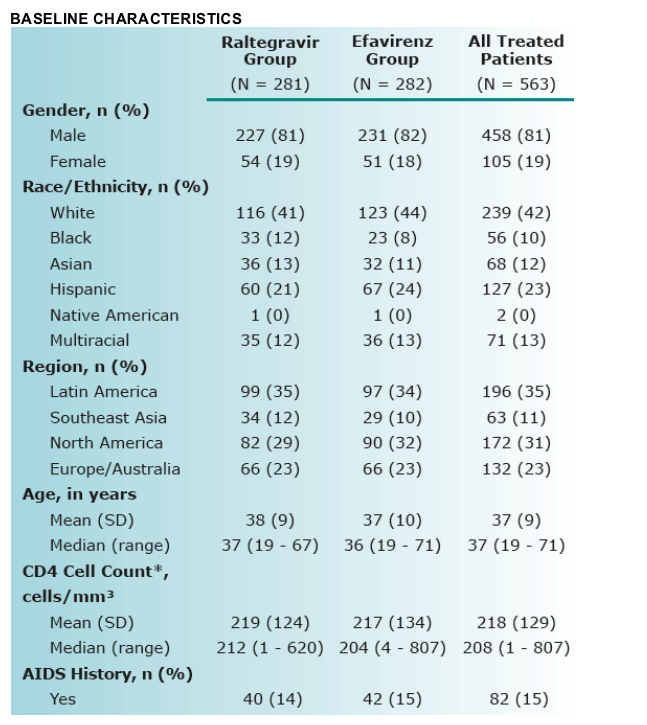
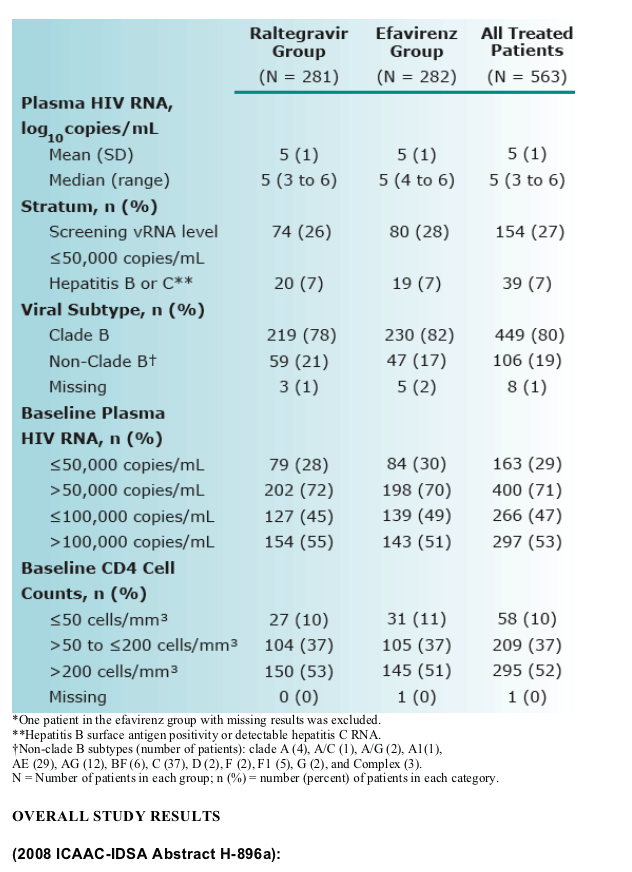
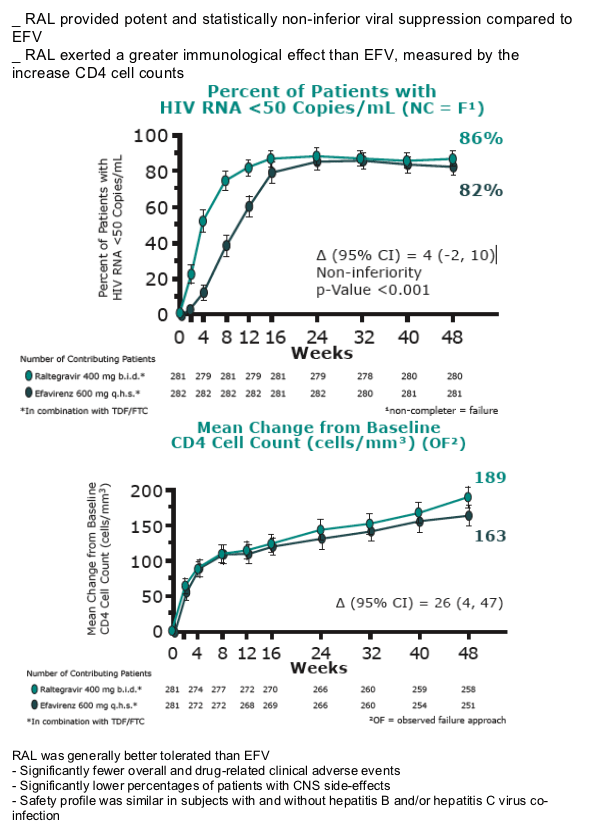
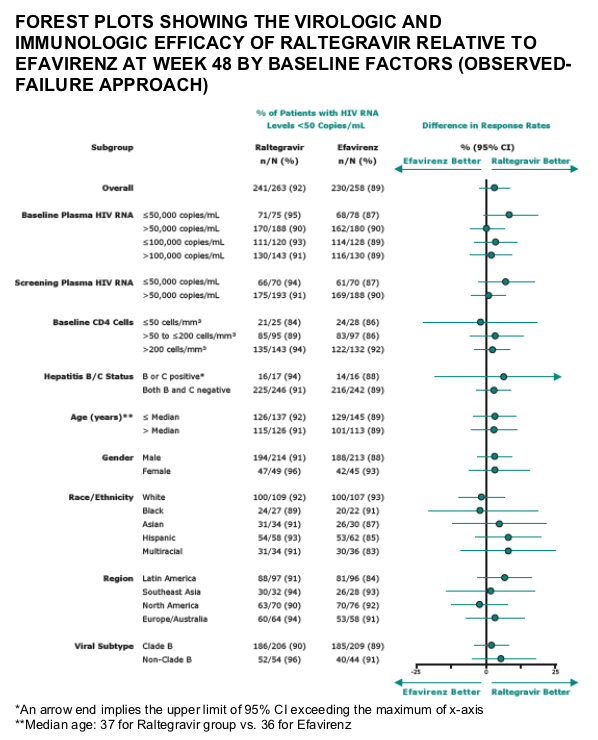
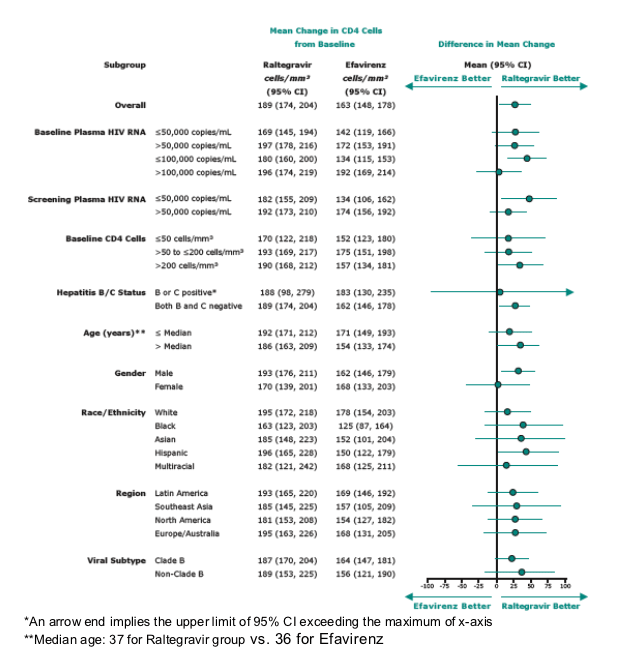
|
| |
|
 |
 |
|
|